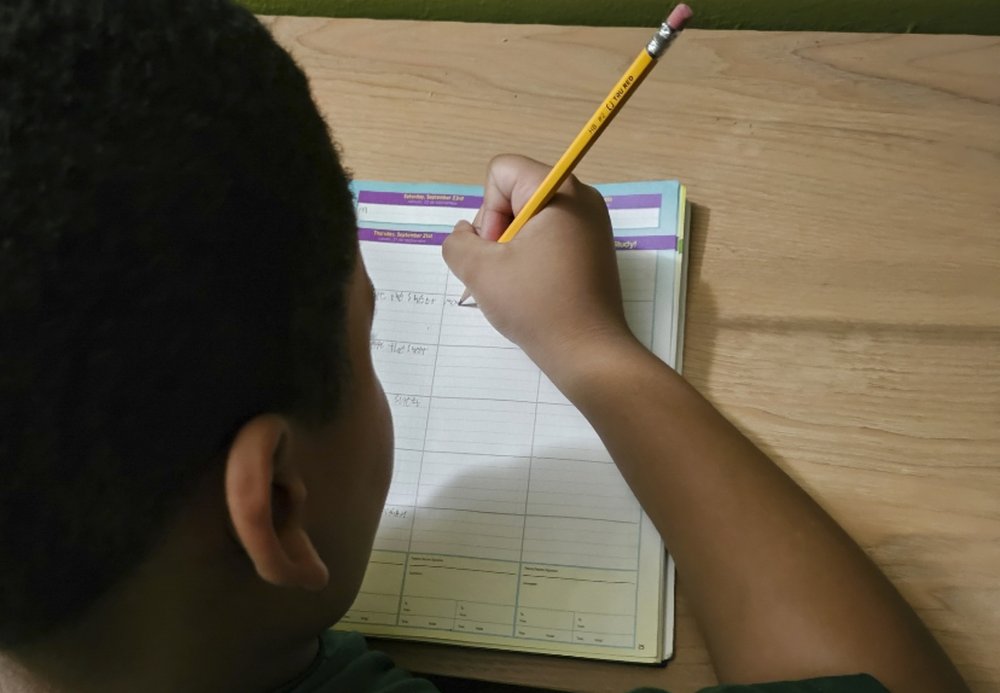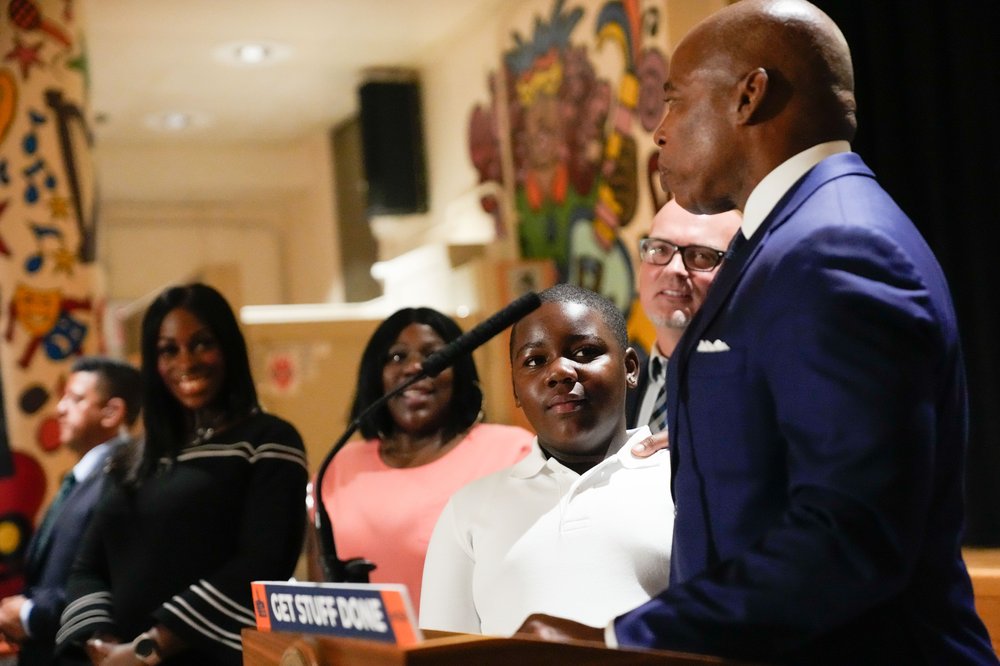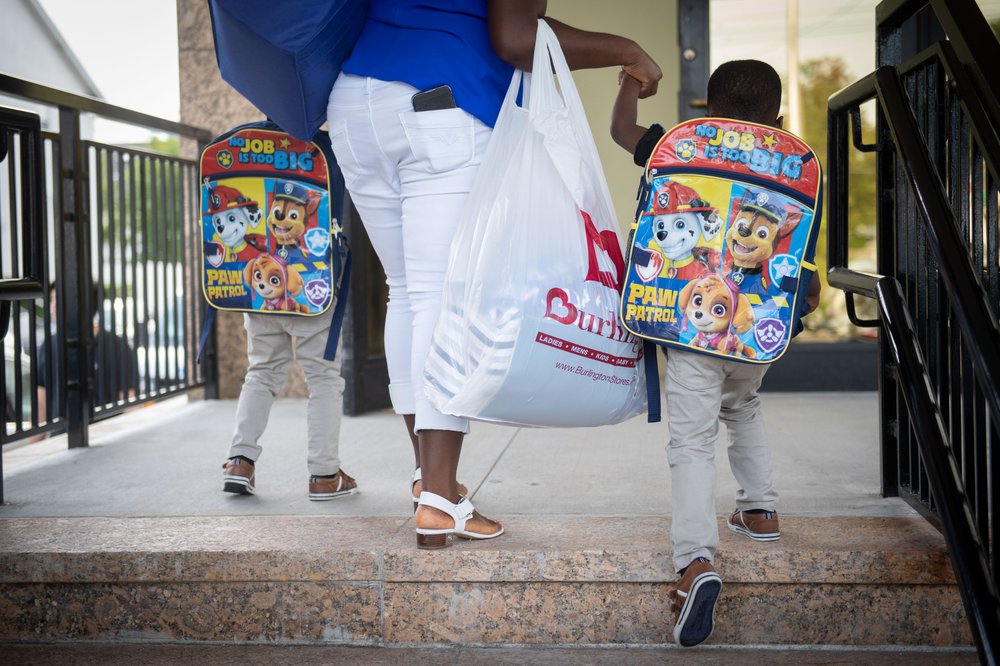Kids with dyslexia still leaving NYC public schools despite Mayor Adams' pledge
Jan. 7, 2025, 6:01 a.m.
Small programs in public schools show promise, but advocates, lawyers and parents say much work needs to be done to improve instruction for kids with the learning disability.

Three years after Mayor Eric Adams made supporting students with dyslexia a top educational priority, parents, advocates and educators say the public school system is still unable to serve too many students with the disability.
Gothamist spoke with parents of 10 students with dyslexia who have either left the school system over the past year, are planning to leave or are suing the education department for private tutoring. They said the dysfunctional system that divides students who struggle to read between the haves and have-nots largely persists. Wealthier families commonly enroll their kids in private schools with better reading instruction, fronting tuition of $75,000 or more and hiring lawyers to sue the education department for reimbursement. Less affluent parents often have little choice but to stay in public schools even as their children fall further and further behind in reading.
- heading
- Dyslexia in NYC public schools
- image
- image
- None
- caption
- body
This is the latest on our coverage of Mayor Eric Adams' plans to address dyslexia in public schools .
- For months, we followed one Harlem student who struggles to read and his family's complex experience to find support. His story was also featured in a podcast.
- Do you suspect your child has a learning disability? This explainer lets you know what to expect.
- The education department overhauled literacy instruction across schools, but teachers said they needed more training on the curriculum.
- Have experience in the public school's system for learning disabilities that you'd like to share? Contact education reporter Jessica Gould at jgould@wnyc.org.
“There’s a lot of kids left out in the cold,” said Adrienne Clark, a Brooklyn parent whose second grader is reading at a pre-K level and was recently diagnosed with dyslexia. "He's struggling. … He doesn't like school. He's having a rough time there and I just feel really sick to my stomach cause I can't just tell him another [public school] would be better cause it feels like the school for him is not out there.”
Experts estimate dyslexic students make up anywhere from 5% to 20% of the student body, and the stakes are high. In 2023, Gothamist reported on one public school student’s struggle to get adequate instruction following a dyslexia diagnosis.
According to the Yale Center for Dyslexia and Creativity, kids with dyslexia who don’t get the help they need are more likely to suffer from depression and anxiety, drop out of school and be unemployed. Multiple studies have also noted high rates of dyslexia among prison populations.
Adams, who is dyslexic, promised early in his term to overhaul literacy instruction and services so dyslexic students could finally be served within the city’s schools. The administration has launched small pilot programs with intensive support for students struggling to read and implemented new literacy curricula at all elementary schools to improve reading instruction.
“This administration is proud to have led the nation in supporting our struggling readers,” city Department of Education spokesperson Nicole Brownstein said.
Advocates cautioned patience while calling for additional improvements. Experts have said major curricular shifts take time, and results often don’t show up until five or 10 years later.
“A very important message that is hard to hear sometimes but very true is that change of this magnitude takes time,” said Kim Sweet, executive director of Advocates for Children of New York.

Nelson Mar, a lawyer at Bronx Legal Services who represents parents suing the education department for private tutoring and school tuition reimbursement, said his caseload of dyslexic students has only dipped slightly since Adams took office in 2022.
“There are clearly huge cracks that children are still continuing to fall through,” Mar said.
‘Not getting the help she needs’
The parents who spoke to Gothamist all had children between the ages of 6 and 9 who are multiple grades behind in reading. Some said the school system had fought them over additional supports like extra help in reading. Others said their schools offered a full array of special education services, but they still weren’t enough.
Clark said her son’s public school has tried to help. It placed him in a class with two teachers, including a special education teacher. It also provided a paraprofessional to keep him on track and signed him up for one-on-one reading support a couple times a week.
But Clark, a special education teacher who works for the education department, said her son needs to be taught by teachers trained in instruction proven to work for kids with dyslexia. She said he also needs to be in a much smaller class where he has more time to practice his skills.
“I just don't get why only people who can afford private school get [that] and the rest of us don’t,” she said.
Most of the city’s private schools for dyslexic students have teachers trained in Orton-Gillingham, considered the gold standard approach, and receive more explicit, repetitive, individualized instruction either one-on-one or in very small groups.
Clark said she is considering sending her son to private school and suing the education department for reimbursement.
”I think I'm going to end up suing my employer, which is not fun and not where I want to be. I want to be like everybody else and send my kids to our zoned school,” she said.
David, 44, from Staten Island said his daughter’s school is also trying to help her address her recent dyslexia diagnosis, but it hasn’t been enough. Her school has offered her occupational therapy and speech therapy, yet she remains roughly two years behind in reading. He said he moved to the neighborhood of Rosebank largely because he liked her public elementary school so much, and hopes his daughter can stay there. He’s planning to sue the city for private Orton-Gillingham tutoring in hopes his daughter can catch up.
David, like many of the parents who spoke to Gothamist, asked to be identified by his first name only because of the anticipated lawsuit.
“There is some improvement throughout the two years she's been receiving help but not to the point where I feel like she should be at,” he said. “She struggles and when it gets too hard, she just gives up. … I would love her to be at grade level, or one level behind, but it’s frustrating and she’s not getting the help she needs.”
Efforts just getting underway
Adams has spoken of the pain he experienced as a student with dyslexia – even sharing a story about how classmates taped signs calling him “dumb” on the back of his chair. In May 2022, he announced the “largest, most comprehensive approach to supporting public school students with dyslexia in the United States” with universal dyslexia screenings and specialized programs.
Under the Adams administration, two dyslexia pilot programs – results of years of activism largely by mothers – launched at public schools in September 2022. The South Bronx Literacy Academy near the Grand Concourse and a program at P.S. 125 in East Harlem differ in approach, but teachers at both are trained in Orton-Gillingham and offer struggling readers more opportunities for practice and coaching. Several Brooklyn schools, including P.S. 107, P.S. 295, and P.S. 154 also received funding for special literacy training for teachers.

Parents of students who participated in the pilot programs said they have been life-changing.
Bronx parent Kerri Fleming said her fourth grade son was diagnosed with dyslexia last summer and only reading at a kindergarten level when he began going to the South Bronx Literacy Academy in September. She’s been floored by his progress.
“I see him reading words. I see him speaking better. His confidence is back. He feels seen,” she said.
The South Bronx Literacy Academy serves 98 students and has planned to open an outpost in Brooklyn next fall. But these pilot programs can only serve a tiny fraction of the school system’s 910,000 students, where 50,000 to 180,000 likely have a form of dyslexia.
Meanwhile, a broader effort by the Adams administration to replace flawed literacy instruction with the materials and techniques that work better for kids with dyslexia and other struggling readers is just getting started. In 2022, then-Schools Chancellor David Banks required all schools to include a stronger emphasis on phonics. The Adams administration has also required all elementary schools to adopt one of three vetted reading curricula and championed universal literacy screenings to help flag struggling students for additional support.
“We remain steadfast in our commitment to our city’s children and their families, and nearly 92% of students in grades K-9 have been screened so far this year,” Brownstein said. “Teachers use the screeners to measure an individual student’s progress, and to inform them of the need for any adjustments to classroom instruction.”
Officials said that 38,000 kids are getting extra support in reading right now.
But so far, reviews of these system-wide reforms are mixed. In a recent survey of 200 teachers, a majority said the shift is having a “positive” or “somewhat positive” effect on instruction, but that they need more support to make the curricula work, particularly for students with disabilities. Some parents have called the new materials boring and rigid. Test scores released last summer showed dips in districts that had already adopted the new curricula.
“In general what teachers are saying is that for a lot of their kids this [new] curriculum is not enough,” Sweet, of Advocates for Children, said. “Our school system is still far from the point where students with dyslexia and other students who struggle with reading can count on getting the level of support they need to be successful readers, and this has to be a priority going forward.”
An NYC student’s yearslong struggle to get proper instruction for dyslexia